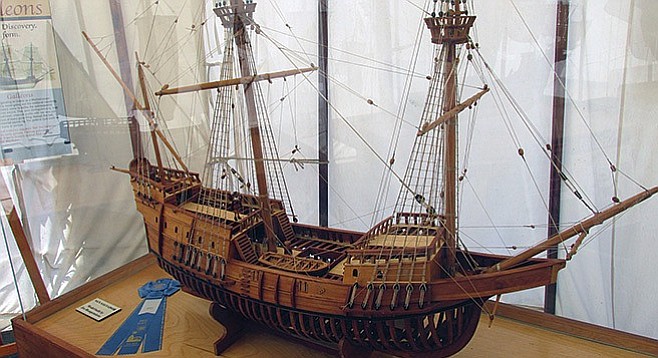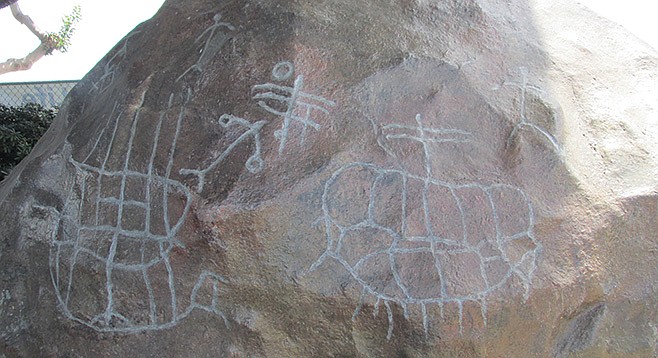 Facebook
Facebook
 X
X
 Instagram
Instagram
 TikTok
TikTok
 Youtube
Youtube

The San Salvador, a replica of Juan Rodriguez Cabrillo’s Spanish galleon being built by the Maritime Museum of San Diego, should hit the water in mid-January.
Facts I learned about Cabrillo while visiting the build site at Spanish Landing:
• Our confusion over how to pronounce his name’s double “ells” probably occurs because — though he’s considered Portuguese — Cabrillo was likely born in Spain. He was sailing under the Spanish flag when he entered San Diego Bay (which he named “San Miguel”) in 1542.
• He owned 12 vessels, which is why the viceroy of New Spain commissioned him to explore the northern waters. Cabrillo would have benefited from captured treasure.
• He had two wives at the same time, an indigenous woman and a woman in Spain. Descendants of his five children live in Guatemala.
• Cabrillo died on his return voyage from a broken leg when he incorrectly stepped off a landing boat on Catalina Island.
• He had not planned to make his historic voyage. His captain got himself shot prior to sailing, so Cabrillo assumed command.
Facts I learned about the San Salvador while visiting the build site:

• There are no detailed drawings of the ship. The replica’s design was first taken from petroglyphs near Jacumba — reflecting what the natives saw coming into the harbor. (The maritime museum staff examined the petroglyphs after reading the June 3, 2009, story in the Reader describing the trail to the petroglyph cave.) Secondly, early sailing vessel requirements were found at Lloyd’s of London; thirdly, from other sunken ships along the West Coast.
• Doug Sharp, a yacht designer and engineer, researched and provided the plans for the replica. He was recently knighted by the king of Spain for his San Salvador research of early Spanish sailing.
• The 100-foot vessel would have carried a crew of 100–150, mostly sleeping on the deck, working in two or three shifts.
• In the 1500s, a vessel would not be seaworthy after five or ten years. The poor workmanship of the time probably explains the many shipwrecks off our coast. The replica’s craftsmanship could last for 200 years.
• There’s no steering wheel, which came later in the 17th Century. The rudder is guided by a “whipstaff,” a vertical stick connected the rudder
• The heavy ship did not tack well in the southbound winds and currents off California. When traveling north, it’s probable that Cabrillo had to drop anchor in the same place he started on some days.
The maritime museum’s build site is open for viewing of the ship’s progress and historical displays. 4300 North Harbor Drive. 619-234-9153. Open 11:00 a.m.–4:00 p.m. daily. $5 admission. Free four-hour parking.


The San Salvador, a replica of Juan Rodriguez Cabrillo’s Spanish galleon being built by the Maritime Museum of San Diego, should hit the water in mid-January.
Facts I learned about Cabrillo while visiting the build site at Spanish Landing:
• Our confusion over how to pronounce his name’s double “ells” probably occurs because — though he’s considered Portuguese — Cabrillo was likely born in Spain. He was sailing under the Spanish flag when he entered San Diego Bay (which he named “San Miguel”) in 1542.
• He owned 12 vessels, which is why the viceroy of New Spain commissioned him to explore the northern waters. Cabrillo would have benefited from captured treasure.
• He had two wives at the same time, an indigenous woman and a woman in Spain. Descendants of his five children live in Guatemala.
• Cabrillo died on his return voyage from a broken leg when he incorrectly stepped off a landing boat on Catalina Island.
• He had not planned to make his historic voyage. His captain got himself shot prior to sailing, so Cabrillo assumed command.
Facts I learned about the San Salvador while visiting the build site:

• There are no detailed drawings of the ship. The replica’s design was first taken from petroglyphs near Jacumba — reflecting what the natives saw coming into the harbor. (The maritime museum staff examined the petroglyphs after reading the June 3, 2009, story in the Reader describing the trail to the petroglyph cave.) Secondly, early sailing vessel requirements were found at Lloyd’s of London; thirdly, from other sunken ships along the West Coast.
• Doug Sharp, a yacht designer and engineer, researched and provided the plans for the replica. He was recently knighted by the king of Spain for his San Salvador research of early Spanish sailing.
• The 100-foot vessel would have carried a crew of 100–150, mostly sleeping on the deck, working in two or three shifts.
• In the 1500s, a vessel would not be seaworthy after five or ten years. The poor workmanship of the time probably explains the many shipwrecks off our coast. The replica’s craftsmanship could last for 200 years.
• There’s no steering wheel, which came later in the 17th Century. The rudder is guided by a “whipstaff,” a vertical stick connected the rudder
• The heavy ship did not tack well in the southbound winds and currents off California. When traveling north, it’s probable that Cabrillo had to drop anchor in the same place he started on some days.
The maritime museum’s build site is open for viewing of the ship’s progress and historical displays. 4300 North Harbor Drive. 619-234-9153. Open 11:00 a.m.–4:00 p.m. daily. $5 admission. Free four-hour parking.
Comments